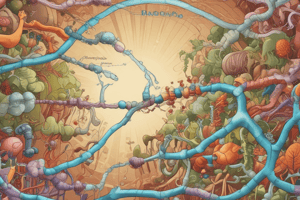Podcast
Questions and Answers
¿Cómo se regula la glucólisis a través de la inhibición por retroalimentación?
¿Cómo se regula la glucólisis a través de la inhibición por retroalimentación?
- Por la fosforilación o desfosforilación de enzimas
- Por la unión de ATP a las enzimas
- Cuando los productos finales de la glucólisis están en altas concentraciones (correct)
- Por la unión de fructosa-2,6-bifosfato a las enzimas
¿Qué enzima convierte el gliceraldehído-3-fosfato (G3P) a 1,3-bisfosfoglicerato (1,3-BPG) en la glucólisis?
¿Qué enzima convierte el gliceraldehído-3-fosfato (G3P) a 1,3-bisfosfoglicerato (1,3-BPG) en la glucólisis?
- Fosfoenolpiruvato carboxicinasa (PEPCK)
- Piruvato quinasa
- Gliceraldehído-3-fosfato deshidrogenasa (GAPDH) (correct)
- Hexoquinasa
¿Cuál es el proceso sintético que genera glucosa utilizando precursores no carbohidratos?
¿Cuál es el proceso sintético que genera glucosa utilizando precursores no carbohidratos?
- Gluconeogénesis (correct)
- Glicólisis
- Glicogénesis
- Gluconeogénesis (correct)
¿Qué enzima cataliza la formación de piruvato a partir de fosfoenolpiruvato (PEP)?
¿Qué enzima cataliza la formación de piruvato a partir de fosfoenolpiruvato (PEP)?
¿Cuál es el producto directo de la conversión de 1,3-bisfosfoglicerato (1,3-BPG) a 3-fosfoglicerato (3-PG) en la glucólisis?
¿Cuál es el producto directo de la conversión de 1,3-bisfosfoglicerato (1,3-BPG) a 3-fosfoglicerato (3-PG) en la glucólisis?
¿Cuál es el proceso metabólico que implica la síntesis de glucógeno a partir de glucosa?
¿Cuál es el proceso metabólico que implica la síntesis de glucógeno a partir de glucosa?
¿Cuál es el producto final de la glucólisis?
¿Cuál es el producto final de la glucólisis?
¿Qué enzima es responsable de la conversión de glucosa a glucosa-6-fosfato en la glucólisis?
¿Qué enzima es responsable de la conversión de glucosa a glucosa-6-fosfato en la glucólisis?
¿Cuál de las siguientes moléculas entra en el ciclo del ácido cítrico tras la glucólisis?
¿Cuál de las siguientes moléculas entra en el ciclo del ácido cítrico tras la glucólisis?
¿Cuál es la función de la Fosfofructoquinasa-1 (PFK-1) en la glucólisis?
¿Cuál es la función de la Fosfofructoquinasa-1 (PFK-1) en la glucólisis?
¿Cuántas moléculas netas de ATP se producen durante la glucólisis?
¿Cuántas moléculas netas de ATP se producen durante la glucólisis?
¿Qué tipo de molécula es el NADH en el contexto de la glucólisis?
¿Qué tipo de molécula es el NADH en el contexto de la glucólisis?
Flashcards are hidden until you start studying
Study Notes
Glycolysis: Unraveling Cellular Energy Production
Glycolysis, a critical metabolic pathway, is the process by which cells convert glucose into pyruvate, which in turn fuels generation of energy through the process of cellular respiration. This fact-rich exploration of glycolysis will delve into its various aspects, including enzymes, regulation, and energy production.
The Glycolysis Process
Glycolysis involves ten enzyme-catalyzed steps that take place in the cytoplasm, ultimately converting one molecule of glucose into two molecules of pyruvate (Figure 1). A net gain of two ATP molecules and two NADH molecules is achieved, along with a two-carbon molecule (acetyl-CoA) that enters the citric acid cycle, amply supplying the cell with energy.
 Figure 1: The glycolysis pathway. This figure is adapted from Wikimedia Commons.
Figure 1: The glycolysis pathway. This figure is adapted from Wikimedia Commons.
Enzymes Involved in Glycolysis
The glycolysis process depends on a series of enzymes, each with a specific role in the conversion of glucose to pyruvate. Here are some key enzymes involved in glycolysis:
- Hexokinase: The first enzyme to bind with glucose, converting it to glucose-6-phosphate (G6P).
- Phosphofructokinase-1 (PFK-1): Catalyzes the phosphorylation of fructose-6-phosphate (F6P) to fructose-1,6-bisphosphate (F1,6BP).
- Glyceraldehyde-3-phosphate dehydrogenase (GAPDH): Converts glyceraldehyde-3-phosphate (G3P) to 1,3-bisphosphoglycerate (1,3-BPG).
- Pyruvate kinase: Catalyzes the formation of pyruvate from phosphoenolpyruvate (PEP).
Regulation of Glycolysis
Glycolysis is a tightly regulated process, ensuring that energy production aligns with cellular demand. Key regulatory points include:
- Allosteric regulation: Enzymes can be activated or inhibited by binding other molecules, such as ATP, citrate, or fructose-2,6-bisphosphate.
- Covalent modification: Enzymes can be regulated by post-translational modifications such as phosphorylation or dephosphorylation.
- Feedback inhibition: Enzymes can be inhibited when the end-products of glycolysis are at high concentrations.
ATP Production in Glycolysis
ATP is produced directly and indirectly in the process of glycolysis.
- Direct ATP production: One ATP molecule is consumed in the initial binding of glucose, but two ATP molecules are generated later in the process: one in the conversion of 1,3-BPG to 3-phosphoglycerate (3-PG) and another when ADP is converted to ATP in the formation of pyruvate from PEP.
- Indirect ATP production: The NADH produced during glycolysis enters the electron transport chain, generating ATP through oxidative phosphorylation.
Glucose Metabolism Pathways
Glycolysis is just one of several metabolic pathways involved in glucose metabolism.
- Glycolysis: A catabolic process that breaks down glucose to produce energy.
- Gluconeogenesis: A synthetic process that generates glucose using non-carbohydrate precursors, such as pyruvate, lactate, and glycerol.
- Glycogenesis: Synthesis of glycogen from glucose.
- Glycogenolysis: Breakdown of glycogen to generate glucose.
Understanding these metabolic pathways is crucial in grasping the complexity of glucose metabolism within cells and the body as a whole.
By exploring these subtopics within the context of glycolysis, one can appreciate its significance in supplying energy to cells and its role in maintaining cellular homeostasis.
Studying That Suits You
Use AI to generate personalized quizzes and flashcards to suit your learning preferences.



